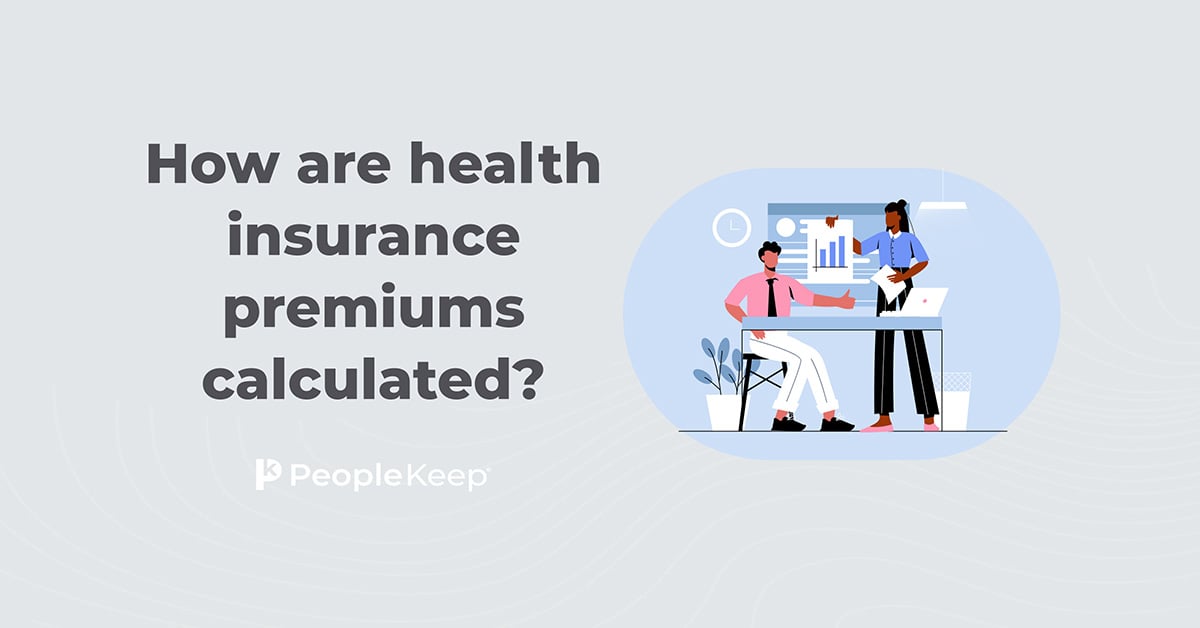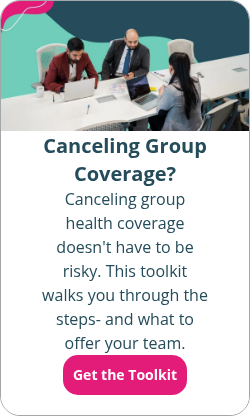Group coverage vs. individual health insurance cost
By Elizabeth Walker on July 5, 2024 at 10:30 AM
Nearly 61% of Americans rely on an employer-selected group health plan for insurance coverage1. However, many Americans purchase an individual health policy because they aren’t eligible for an employer-sponsored group plan, want more choice over their healthcare, or for other reasons.
If you aren't able to participate in a group health plan or have the option to choose between group and individual insurance coverage, you need to know the differences to make the right call for you and your family.
In this article, we’ll go over the average cost of both group and individual health insurance and cover additional benefit options that can make your insurance more affordable.
Takeaways from this blog post:
- In 2023, the average monthly premium for group health insurance was $703 for self-only coverage and $1,997 for family coverage.
- The average monthly premium for a self-only individual health insurance plan was $456 in 2023. A family of four paid an average of $1,437 monthly for an unsubsidized plan.
- Whether you have group or individual health insurance, a health reimbursement arrangement (HRA) from your employer can help you save money on your out-of-pocket medical expenses.
How much does group health insurance cost?
Employer-based health insurance covers about 165 million people, making it the most popular coverage option today. Providing health insurance is a great way for businesses to gain a competitive edge in hiring, boost employee retention, and improve workplace satisfaction and productivity.
Group health insurance premiums can vary by age, number of participating employees, the company’s medical claim history, industry, etc. But to give you an idea, KFF conducts an annual survey that provides some insight into the cost of employer-sponsored health insurance2.
In 2023, the average amount that employees contributed toward the cost of health employer-sponsored insurance premiums was:
- $703/month for self-only coverage
- $1,997/month for family coverage
The average premium costs for employer-sponsored self-only plans have remained roughly the same over the past few years. However, the average premium for family coverage has increased by 22% over the last five years and 42% over the previous ten years.
In 2023, employers contributed roughly $7,034 yearly toward self-only premiums and about $17,393 toward family premiums.
Rising health insurance rates impact employers and employees alike. When estimating the cost of health insurance, employees should factor in the premiums' cost and consider their annual deductible to see if their plan is feasible.
The average deductible for single coverage in 2023 was $1,735, slightly lower than the 2022 deductible. However, the average deductible for single coverage has increased by 10% over the past five years. Health insurance deductibles may continue to rise in the coming years.
How much does individual health insurance cost?
If your employer doesn’t offer you health insurance as part of an employee benefits program, you have another option. You can purchase an individual health plan through a private or public exchange. Private exchanges include working with insurance agents, brokers, and health insurance companies directly. Public exchanges are state-based marketplaces and the federal health insurance marketplace.
It’s normal for consumers to be concerned about the cost of an individual insurance policy. Historically, health insurance rates can be unpredictable, and each company differs.
Luckily, the Affordable Care Act (ACA) makes your monthly health insurance premium more predictable. Health insurance carriers can no longer determine your price based on certain factors, such as gender or a pre-existing condition.
An ACA-compliant plan must also include certain covered medical services. Plans must cover the ten essential health benefits, such as preventive services, hospitalization, and mental health care.
The average monthly cost of care with individual health insurance varies depending on certain factors like:
- Age
- Annual income
- Location
- Dependents
- Healthcare use
- Metal plan tier—either bronze, silver, gold, or platinum health insurance plans
In 2023, the average monthly premium for a 40-year-old on a benchmark plan without premium tax credits was $4563. A benchmark plan is the second-lowest-cost silver plan tier on public marketplaces. Family plan premium rates will vary based on family size. But, a family of four paid an average of $1,437 a month for an unsubsidized plan4.
Depending on your annual income level and other necessary information, you may qualify for premium tax credits through the marketplace. These cost-saving subsidies can help you purchase affordable health insurance coverage. However, you can only receive these subsidies for marketplace plans, not those you purchase on a private exchange.
Individual health insurance vs. group health insurance cost
When you compare individual and group plan coverage options, it’s easy to see individual health insurance policies tend to be more affordable than employer-sponsored plans.
|
Average individual health plan premiums |
Average group health plan premiums |
|
|
Self-Only |
$456/month |
$703/month |
|
Family |
$1,437/month |
$1,997/month |
However, there are other factors to consider when choosing health insurance. You should search for exchange plans based on all relevant information and factors to you, including where you live, choice of plan, network doctors, out-of-pocket maximum, and covered services.
The right type of plan for you isn’t just affordable—it should also suit your and your family’s medical care needs. If you need help choosing a medical insurance plan, you can always work with a licensed insurance agent or a broker. They’ll help you review your health plan options and find the health plan that best meets your needs.
How personalized health benefits can help you with monthly premium costs
Whether you have an employer-sponsored plan or an individual policy, if your employer offers a health reimbursement arrangement (HRA), you can save on your healthcare costs.
HRAs allow employers to reimburse employees tax-free for qualifying out-of-pocket costs and, sometimes, individual health insurance premiums.
With an HRA, employers control their monthly costs by determining how much of an allowance to offer their employees. After submitting, reviewing, and verifying employee-submitted expenses, employers reimburse employees up to their allowance amount.
The type of HRA you’re eligible for depends on the type of medical coverage you have. Let’s look at three popular HRAs that PeopleKeep offers to employers that can support their staff: the qualified small employer HRA (QSEHRA), the individual coverage HRA (ICHRA), and the integrated HRA.
Qualified small employer HRA (QSEHRA)
With a QSEHRA, employees purchase the health insurance plan of their choice. Then, after making an approved purchase, their employer reimburses them for their monthly premium and other eligible out-of-pocket costs. To qualify, your employer must have fewer than 50 full-time equivalent employees (FTEs) and not offer a group health insurance policy.
While individual plan premiums, deductible expenses, and other actual expenses typically vary yearly, the QSEHRA has annual contribution limits set by the IRS. This means your employer can only offer you a maximum amount of tax-free money through the benefit.
All full-time W-2 employees are automatically eligible for the QSEHRA. Part-time employees can also join the benefit as long as the employer offers them the same allowance amount as full-time employees. In either case, only employees with a health plan that provides minimum essential coverage (MEC) can participate.
Individual coverage HRA (ICHRA)
The ICHRA allows your employer to give you a set monthly allowance to pay for individual health plan premiums and other qualified medical costs, like prescription drugs, doctor visits, and over-the-counter items. While similar to the QSEHRA, the ICHRA is for employers of any size and has no minimum or maximum contribution limits.
Before collecting reimbursements, employees must regularly attest to having a qualifying form of individual health coverage. Additionally, employees can opt in or out of the benefit based on affordability.
The ICHRA is only available to workers with an individual plan. This means if you’re covered by a family member's or spouse’s employer plan or participate in a healthcare sharing ministry, you won’t be eligible for the ICHRA benefit.
Integrated HRA
If your employer is determined to offer a group health plan, you can see if they’ll supplement it with an integrated HRA. This type of HRA, also known as a group coverage HRA (GCHRA), is for businesses of all sizes that specifically offer a group health insurance policy. In this case, only employees who opt into the employer-sponsored health plan can participate in the HRA.
With an integrated HRA, you can receive tax-free reimbursements for any eligible expenses your group health insurance policy doesn’t fully pay for, such as deductibles, coinsurance, and other healthcare items. However, you can’t receive reimbursements on your group plan premium payments.
Like the ICHRA, there are no minimum or maximum allowance limits, making it a flexible option for every employee’s needs.
Health stipends
Whether your employer chooses group health insurance or encourages you to get individual health insurance, you'll reap benefits if they offer a health stipend. Stipends can compliantly work alongside an HRA and group health insurance to create a more comprehensive benefits package.
A health stipend is a flat amount of money employers give to employees to help them pay for health insurance and other out-of-pocket expenses. Stipends are an informal but beneficial perk as they’re flexible enough to meet every employee’s needs.
Stipends are essentially extra money added to an employee’s paycheck to use on whatever they choose. It’s important to note that your employer can’t require you to use your stipend money on healthcare items unless they use a reimbursement model, nor can they ask for proof that you used the money to buy a health insurance policy.
The federal government considers stipend money taxable income for employees, and employers are subject to payroll taxes. However, stipends still offer great personalization for employees wanting to control their healthcare and finances even more.
Conclusion
While most U.S. employees have a group health insurance policy, much has changed in recent years. A growing trend is for employees to browse health plan options on the individual market or work with an insurance agent and purchase their own policy. Not only is individual health insurance less expensive than group policies, but it offers you more choice and flexibility over your and your family’s medical needs.
Whether you have an individual policy from the health insurance marketplace or are participating in a group health policy, if your employer offers an HRA or health stipend, you can leverage that to save on health costs.
This article was originally published on July 29, 2020. It was last updated on July 5, 2024.
2. https://www.kff.org/report-section/ehbs-2023-summary-of-findings/
Check out more resources
See these related articles

Health insurance reimbursements: What are the options?
Explore your options for health insurance reimbursement. Understand what insurance reimbursement means and how HRAs can support employees.

Why do health insurance premiums increase?
Learn why health insurance premiums increase. Discover the factors behind rising costs and what to consider if your health insurance went up.

How are health insurance premiums calculated?
Ever wonder how health insurance premiums are determined? This comprehensive blog breaks down the factors that influence the cost of your health insurance.



